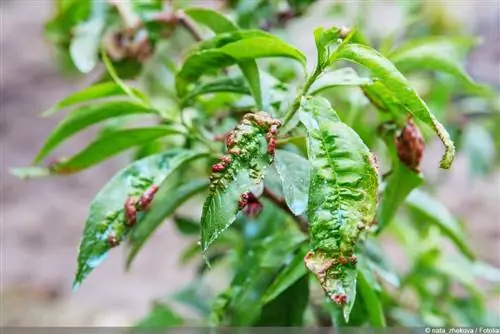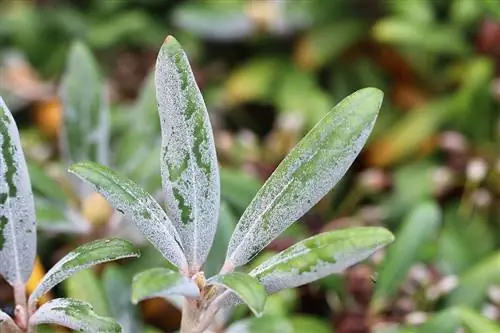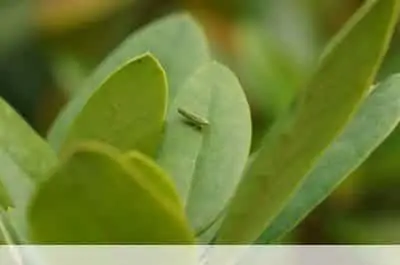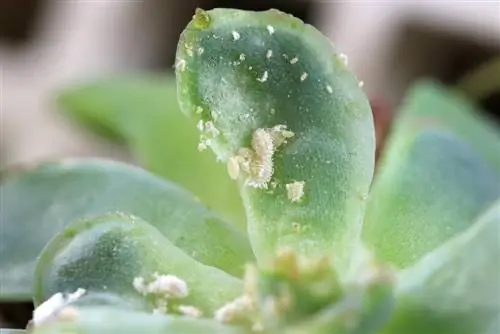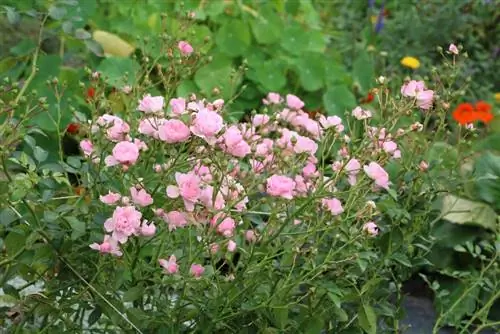- Author admin [email protected].
- Public 2023-12-17 03:39.
- Last modified 2025-01-24 12:45.
The fungal pathogen has the beautiful name Taphrina pruni. What he does in the gardens, however, is less pleasing. The clearest sign of the so-called fool's and pocket disease is stunted fruit on the plum tree. Although the infected fruits can no longer be saved, it is still important to act quickly. Without preventive measures, the fungus survives the winter and strikes again the following year.
Susceptible fruit trees
Fool's disease mainly affects plum and plum trees. The cause of the disease is the fungal pathogen Taphrina pruni. In wet weather it spreads particularly quickly and can even spread to neighboring trees. Apricot and apricot trees can also be affected. Bird cherries and renecludes are also rarely affected. However, among the fruit trees mentioned, there are some varieties that are more resistant to this fungus. You are largely spared from the pocket disease.
malicious image
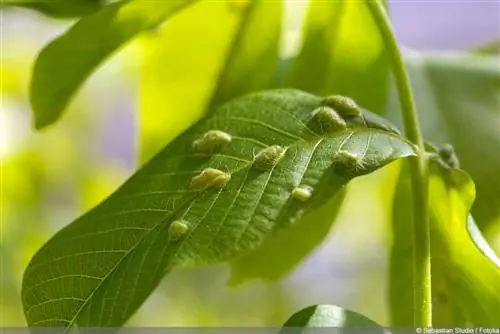
Released fungal spores are transmitted by wind. They colonize crevices in the bark and flower buds of susceptible fruit trees. The fruit tree affected by pocket disease does not show immediately visible symptoms. The fungal spores initially continue to grow and germinate unnoticed. Once conditions are favorable, the fungus grows faster, forming thread-like tubes and penetrating plant tissue. The stems swell and become deformed. These changes are rather inconspicuous and are usually not noticed by “ignorant” fruit tree owners. The fungus that lives in the inner tissue infects numerous flowers in the following years. The infection occurs mainly in cool and rainy weather. The infected flowers produce fruits that bear the clear signs of pocket disease and can no longer be overlooked.
- the infected fruits grow faster than he althy fruits
- become about 4 to 6 cm long and up to 2 cm thick
- they have a curved shape, similar to a pod
- initially the fruit skin is smooth and light green
- later they are covered with a floury coating
- appear grey/yellowish
- Flesh remains green and juiceless
- the core is missing inside
- instead there is an elongated cavity
- Fruits are not poisonous but they are useless
- after the spores are thrown out, the fruits shrink
- they rot and some fall off sooner
- However, many of the shriveled fruits stubbornly remain stuck
- until winter and spring
Note:
The fruits deformed by fool's disease are also popularly known as starvation plums and cobbler's plums.
Chemical control
The effects of fool's disease can be frightening - even from a purely visual perspective. Many fruit tree owners immediately think of a fungicide that would destroy the fungus immediately and completely. But be careful: In this case, it is best to leave fungicides on the shelf. There is currently no effective chemical agent approved for chemical control of the pocket disease in the home and allotment area. Since the diseased tree poses no serious danger, the well-being of the environment comes first. Chemical agents are not only fatal to the fungus, they can also cause damage to people and nature. So if you want to combat pocket disease effectively, you have to resort to a bunch of alternative methods.
Choice of varieties
The course for a he althy fruit tree can be set when the tree is planted. Among the numerous varieties of plums and plums, there are some that are more resistant to Taphrina pruni:
- Anna Späth
- Bühler
- Cacaks Best
- Cacaks Beautiful
- Hanita
- President
- Toppers
- Tophit
- Valjevka
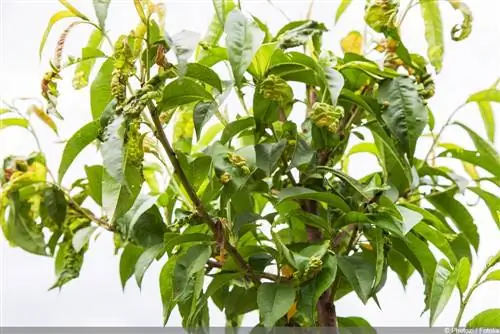
In general, early-flowering varieties are more resilient than late-flowering varieties. When choosing a variety, it should also be noted that some varieties are very maintenance-intensive. Only with proper care do they produce the expected fruit in terms of taste. They are more suitable for commercial cultivation and less suitable for a home garden.
Tip:
If the tree has already been planted, it may also be worthwhile to re-graft it with one of the robust varieties. A local tree nursery can provide appropriate support.
Control tree
A fungal disease spreads extremely quickly under optimal conditions. The earlier the symptoms of the disease are discovered and correctly interpreted, the quicker appropriate measures can be taken to address the cause. Plum and damson trees should be inspected every spring. This makes it easier to identify the typical damage caused by an advanced infection.
Thinning out the crown
The pathogen that causes pocket disease likes damp and cool weather. The risk of infection is particularly high in rainy years. The risk of disease increases even further if the rain-soaked leaves cannot dry quickly.
- ensure a loose crown structure
- Cut the tree regularly
- thinning annually
- the winter rest period is ideal for this
- choose a dry and sunny day
- professional cutting brings air and light into the crown
- sometimes whole branches have to go
- close large cuts
- for example with tree wax
- Moisture can evaporate more quickly
Tip:
When planting trees, make sure from the outset that individual trees are not too close together.
Destroy diseased fruits
If diseased fruits appear on the fruit tree in June, the fool's disease is already fully under control. This part of the harvest is irretrievably lost. Now it is important to combat the cause and keep the damage to a minimum. Further infections should be avoided. The diseased fruits carry the fungal pathogen and therefore represent a potential risk of infection.
- pick all diseased fruits
- best before the fruit continues to develop
- also pick up fallen fruit
- Wear gloves or wash and disinfect hands thoroughly
- do not leave so-called fruit mummies on the tree
- Do not put fruits on the compost heap
- the fungal pathogen can survive there
- Dispose of diseased fruits with household waste
- you can also put it in the organic waste bin
- Burning is the safest way to destroy the fungal spores
The reproductive cycle of the fungus is only interrupted if all diseased fruits are thoroughly and completely disposed of.
Note:
Don't worry, the diseased fruits are not poisonous, just tasteless and inedible.
Remove diseased shoot tips
The damage caused by pocket disease also includes infected shoots, which can be visibly recognized as such. In addition to stuck fruits from the previous year, the flowers are also infected in spring via these diseased shoot tips. Therefore, this cause must also be addressed in a timely manner.
- best during winter pruning
- look out for conspicuous shoots
- infected shoots are usually thickened, twisted or somehow deformed
- cut off all such shoots completely
- Shoots discovered later should be removed immediately
- regardless of the season
Note:
The cutting tool should be disinfected before and after cutting diseased tree parts to avoid further infections.
Preventive sprays
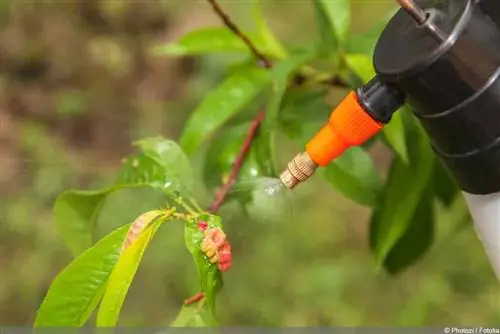
With this disease, too, there is no lack of home remedies that are supposed to help against this fungal pathogen. Teas or broths are prepared from various plants and injected as a preventive measure. The following plants are said to help against the damage caused by fool's disease:
- garlic
- Horseradish
- tansy
- Horsetail
The sprayings promise success as long as they are carried out in good time in the spring. To increase the protective effect, you should spray several times if possible.
- at the beginning of flowering
- during flowering
- to the end of blooming
- preferably on a sunny morning
Which plant is ultimately used to produce the spray mixture also depends on its immediate availability. There are numerous recipes for broths and teas on the Internet.
lime paint
In winter, the combination of freezing temperatures and sunshine occasionally occurs. The side of the tree facing the sun warms up while the other side stays cooler. This temperature difference causes cracks in the bark. They are a gateway to all sorts of pathogens, including pocket disease. Thanks to the white color, the lime paint reflects the sun's rays so that the exposed side cannot heat up as much. Cracks remain. Coating the tree with lime reduces the risk of infection. In addition, it has other protective effects that contribute to plant he alth.
Tip:
The ideal time for a lime coat is the months of October and November. Young trees in particular benefit from a protective lime coating.
Strengthening fruit trees
A he althy tree has strong defenses. Pathogens then find it difficult to gain the upper hand. The ideal tree care depends on the fruit tree variety and should be adhered to throughout. In addition, the following can strengthen plant he alth:
- mulching the tree disc
- annual compost donations
- Spraying and/or watering with compost tea
Tip:
Specialist stores also offer special plant strengtheners that increase the vitality of the tree.
Combat across gardens
It's no use fighting fool's disease on your own tree with all the means available when there are still diseased trees in the nearby area. The fungal spores can be carried many meters by wind and can repeatedly infect he althy or recovered trees.
- Take a closer look at neighboring gardens
- if necessary, contact the owner
- perhaps the illness has escaped him so far
If the disease in neighboring trees is successfully addressed, the risk of infection is significantly reduced. This means your own tree stays he althy for longer.

